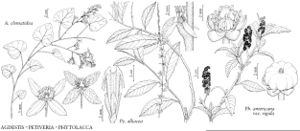Agdestis clematidea
Syst. Nat. 1: 543. 1817.
Stems climbing, to 25 m, pubescent to glabrate. Leaves: petiole 2–5 cm; blade ovate to reniform, to 9 × 5.5 cm, base cordate, apex obtuse to rounded, often mucronate. Panicles 4–15 cm; peduncle 2–10 cm; pedicel 1–10 mm. Flowers: sepals white to greenish white, reticulate-veined, oblong to ovate or obovate, 4–6.5 mm. Cypselas 2.5 mm (perhaps not maturing in se U.S.), crowned by winglike sepals to 6 × 3 mm.
Habitat: Hammocks, orchards, waste places, ravines
Elevation: 0-30 m
Distribution
Fla., Tex., Mexico, Central America, native to subtropical and tropical America.
Discussion
Of this species, N. L. Britton (1904) wrote, “The flowers and inflorescence are wonderfully Clematis-like, greatly resembling those of Clematis Vitalba of Europe and…those of our own Clematis Virginiana. But the most striking thing about the plant is its horrid odor, the flowers being, if anything, more fetid than those of the carrion-flower or skunk-cabbage….”
The root of Agdestis clematidea allegedly can weigh as much as 68 kg and resemble a large boulder.
